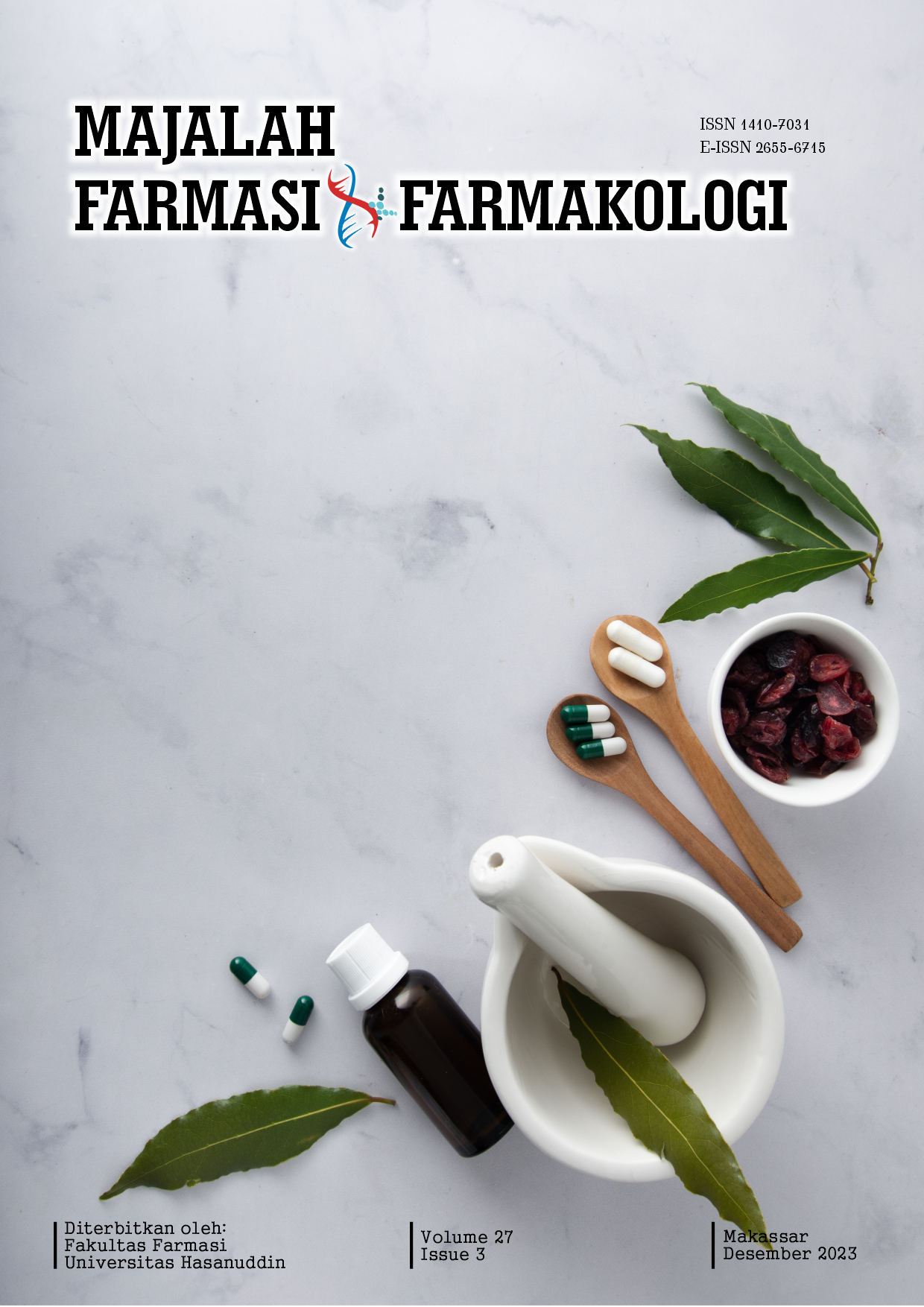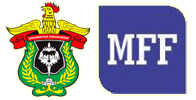PENGARUH METODE EKSTRAKSI TERHADAP KADAR POLIFENOL TOTAL BIJI KAKAO (Theobroma cacao L.) KLON MCC02 ASAL SULAWESI SELATAN
Keywords:
Theobroma cacao L., Klon MCC02, polifenol total , metode ekstraksiAbstract
Indonesia merupakan salah satu produsen kakao (Theobroma cacao L.) di dunia dengan berbagai genotype / klon. Salah satu klon terbesar di Sulawesi selatan adalah MCC02 (Masamba Cacao Clone 02). Klon tersebut telah ditanam di beberapa kabupaten di Sulawesi selatan. Polifenol kakao diketahui memiliki aktivitas antioksidan dan antimikroba. Biji kakao mengandung komponen polifenol yang tinggi, salah satu faktor yang mempengaruhi kadar polifenol dalam ekstrak adalah metode ekstraksi. Tujuan penelitian ini adalah untuk mengetahui pengaruh dari metode ekstraksi terhadap kadar polifenol dari ekstrak biji kakao. Buah kakao klon MCC02 diperoleh dari tiga kabupaten yaitu Pinrang, Masamba, dan Bantaeng. Biji kakao kering non fermentasi terlebih dahulu dikeluarkan dari kulit bijinya, kemudian lemaknya dihilangkan dengan menggunakan alat press lemak. Biji kakao tersebut masing-masing diekstraksi menggunakan metode maserasi (M), Microwave Assisted Extraction (MAE), dan Ultrasonic-Assisted Extraction (UAE). Hasil ekstraksi dengan menggunakan metode M, MAE dan UAE diperoleh rendemen, masing-masing: 15,29 ± 0,66 %, 13,13 ± 0,28 % dan 12,77 ± 1,12 % dan kandungan rata-rata polifenol total, yaitu: (28,89 ± 4,53) %, (31,90 ± 3,34) %, (36,07 ± 4,41) % dihitung ekivalen asam galllat. Dari ketiga metode ini kadar polifenol total tertinggi ada pada metode ekstraksi menggunakan Ultrasonic-Assisted Extraction (UAE).References
Aguilar-Hernández, G., De Lourdes García-Magaña, M., De los Ángeles Vivar-Vera, M., Sáyago-Ayerdi, S. G., Sánchez-Burgos, J. A., Morales-Castro, J., Anaya-Esparza, L. M., & González, E. M. (2019). Optimization of ultrasound-assisted extraction of phenolic compounds from annona muricata by-products and pulp. Molecules, 24(5), 1–15. https://doi.org/10.3390/molecules24050904
Ariyanti, M., Rosniati, R., Yumas, M., Wahyuni, W., & Indriana, D. (2021). Kandungan Asam Amino Dan Asam Lemak Kakao Bubuk Tidak Fermentasi Dengan Perlakuan Penyangraian Uap Panas Suhu Rendah. Jurnal Industri Hasil Perkebunan, 16(2), 70. https://doi.org/10.33104/jihp.v16i2.7052
Biesaga, M. (2011). Influence of extraction methods on stability of flavonoids. Journal of Chromatography A, 1218(18), 2505–2512. https://doi.org/10.1016/j.chroma.2011.02.059
Febrianto, N. A., & Zhu, F. (2019). Diversity in Composition of Bioactive Compounds among 26 Cocoa Genotypes. Journal of Agricultural and Food Chemistry, 67(34), 9501–9509. https://doi.org/10.1021/acs.jafc.9b03448
Febrianto, N. A., & Zhu, F. (2022). Composition of methylxanthines, polyphenols, key odorant volatiles and minerals in 22 cocoa beans obtained from different geographic origins. Lwt, 153(August 2021), 112395. https://doi.org/10.1016/j.lwt.2021.112395
Gil, M., Uribe, D., Gallego, V., Bedoya, C., & Arango-Varela, S. (2021). Traceability of polyphenols in cocoa during the postharvest and industrialization processes and their biological antioxidant potential. Heliyon, 7(8), e07738. https://doi.org/10.1016/j.heliyon.2021.e07738
Kemenkes R.I. (2011). Suplemen II Farmakope Herbal Indonesia (Direktorat Jenderal Bina Kefarmasian dan Alat (ed.); FIrst Edit). Kemenkes R.I.
Maldonado, Y. E. (2023). Drying Temperature on Catechins , Procyanidins and.
Martin, M. Á., & Ramos, S. (2021). Impact of cocoa flavanols on human health. Food and Chemical Toxicology, 151(March). https://doi.org/10.1016/j.fct.2021.112121
Medina-Torres, N., Ayora-Talavera, T., Espinosa-Andrews, H., Sánchez-Contreras, A., & Pacheco, N. (2017). Ultrasound assisted extraction for the recovery of phenolic compounds from vegetable sources. Agronomy, 7(3). https://doi.org/10.3390/agronomy7030047
Montagna, M. T., Diella, G., Triggiano, F., Caponio, G. R., De Giglio, O., Caggiano, G., Di Ciaula, A., & Portincasa, P. (2019). Chocolate, “food of the gods”: History, science, and human health. International Journal of Environmental Research and Public Health, 16(24). https://doi.org/10.3390/ijerph16244960
Oracz, J., Zyzelewicz, D., & Nebesny, E. (2015). The Content of Polyphenolic Compounds in Cocoa Beans (Theobroma cacao L.), Depending on Variety, Growing Region, and Processing Operations: A Review. Critical Reviews in Food Science and Nutrition, 55(9), 1176–1192. https://doi.org/10.1080/10408398.2012.686934
Sari, I. A., Murti, R. H., Misnawi, Putra, E. T. S., & Susilo, A. W. (2022). Sensory profiles of cocoa genotypes in Indonesia. Biodiversitas, 23(2), 648–654. https://doi.org/10.13057/biodiv/d230205
Downloads
Published
Issue
Section
License
Copyright (c) 2023 Majalah Farmasi dan Farmakologi

This work is licensed under a Creative Commons Attribution-NonCommercial 4.0 International License.
The copyright to this article is transferred to Universitas Hasanuddin (UNHAS) if and when the article is accepted for publication. The undersigned hereby transfers all rights in and to the paper including without limitation all copyrights to UNHAS. The undersigned hereby represents and warrants that the paper is original and that he/she is the author of the paper, except for material that is clearly identified as to its original source, with permission notices from the copyright owners where required. The undersigned represents that he/she has the power and authority to make and execute this assignment.
We declare that:
- This paper has not been published in the same form elsewhere.
- It will not be submitted anywhere else for publication prior to acceptance/rejection by this Journal.
- A copyright permission is obtained for materials published elsewhere and which require this permission for reproduction.
Furthermore, I/We hereby transfer the unlimited rights of publication of the above-mentioned paper in whole to UNHAS The copyright transfer covers the exclusive right to reproduce and distribute the article, including reprints, translations, photographic reproductions, microform, electronic form (offline, online) or any other reproductions of similar nature.
The corresponding author signs for and accepts responsibility for releasing this material on behalf of any and all co-authors. This agreement is to be signed by at least one of the authors who have obtained the assent of the co-author(s) where applicable. After submission of this agreement signed by the corresponding author, changes of authorship or in the order of the authors listed will not be accepted.


